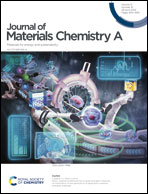Boosting the charge for the selective photoelectrochemical oxidation of hydroquinone in hazardous environments using a fine-tuned heterojunction catalyst†
Abstract
In this work, a sensitive and selective photoelectrochemical (PEC) catalyst was synthesized by strongly interfacing two semiconductors to form a heterojunction catalyst. The PEC catalyst was prepared via the ultrasonication of a hydrothermally prepared mixture of Bi2S3 and BiFeO3. The PEC catalyst was characterized using SEM/EDAX, HR-TEM/SAED, XRD, XPS, UV-vis-near IR DRS, and electrochemical methods. The conduction, valence bands and band gaps of the composite were determined. The oxidation mechanism on the PEC catalyst resulted in effective hydroquinone (HQ) conversion and H2O2 generation. Fine-tuning of the PEC structure allowed its application under visible light for the determination of HQ with high sensitivity and selectivity in different environments. Thus, the PEC catalyst was successfully employed for the assay of HQ in tap water, sewage and industrial waste dump areas. The LOD and sensitivities of HQ were 2.73 nM and 14.9 A/M under illumination and 49.2 nM and 0.239 A/M in the dark in the concentration range of 100 nM to 100 μM, respectively.



 Please wait while we load your content...
Please wait while we load your content...